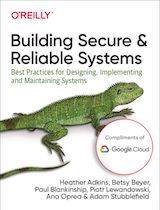
|
FreeComputerBooks.com
Links to Free Computer, Mathematics, Technical Books all over the World
|
|
- Title: Building Secure and Reliable Systems: Best Practices for Designing, Implementing, and Maintaining Systems
- Author(s) Heather Adkins, Betsy Beyer, Paul Blankinship, Ana Oprea, Piotr Lewandowski, Adam Stubblefield
- Publisher: O'Reilly Media (April 7, 2020); eBook (Compliments of Google Cloud)
- Permission: Free eBook Complimented by Google Cloud
- Paperback: 558 pages
- eBook: PDF (557 pages), ePub, and MOBI
- Language: English
- ISBN-10: 1492083127
- ISBN-13: 978-1492083122
- Share This:

|
Can a system be considered truly reliable if it isn't fundamentally secure? Or can it be considered secure if it's unreliable? Security is crucial to the design and operation of scalable systems in production, as it plays an important part in product quality, performance, and availability. In this book, experts from Google share best practices to help your organization design scalable and reliable systems that are fundamentally secure.
About the Authors- N/A
- Computer, Networks, and Information Security. Cybersecurity
- Software Engineering Principles and Practices
- Software Containers & Virtualization
- Cloud Computing, Serverless, and Distributed Systems, etc.
- Books by O'Reilly®

- Building Secure and Reliable Systems (Heather Adkins, et al.)
- The Mirror Site (1) - PDF
- Bppk Homepage (Other Books, etc.)
-
 Security as Code: DevSecOps Patterns with AWS (BK Das, et al.)
Security as Code: DevSecOps Patterns with AWS (BK Das, et al.)
It demonstrates how to use this methodology to secure any application and infrastructure you want to deploy. You'll learn how to create a secure containerized application with Kubernetes using CI/CD tooling from AWS and open source providers.
-
 A Practical Guide to Cloud Migration (Kieran Broadfoot, et al.)
A Practical Guide to Cloud Migration (Kieran Broadfoot, et al.)
You'll learn how to modernize your applications by using cloud for containerization, DevOps, microservices, and serverless solutions to reduce development time and costs, while also making your applications robust, secure, and scalable.
-
 Hacking Kubernetes: Threat-Driven Analysis and Defense
Hacking Kubernetes: Threat-Driven Analysis and Defense
It begins with a vanilla Kubernetes installation with built-in defaults, then examines an abstract threat model of a distributed system running arbitrary workloads, and then progress to a detailed assessment of each component of a secure Kubernetes system.
-
 Kubernetes Patterns: Designing Cloud-Native Applications
Kubernetes Patterns: Designing Cloud-Native Applications
This book provides common reusable elements, patterns, principles, and practices for designing and implementing cloud-native applications on Kubernetes. It is based on use cases and lessons learned from real-world projects.
-
 Kubernetes: Up and Running: Dive into the Future of Infrastructure
Kubernetes: Up and Running: Dive into the Future of Infrastructure
This practical book shows developers and ops personnel how Kubernetes and container technology can help you achieve new levels of velocity, agility, reliability, and efficiency. It explains how this system fits into the lifecycle of a distributed application.
-
 Kubernetes for Full-Stack Developers (Jamon Camisso, et al)
Kubernetes for Full-Stack Developers (Jamon Camisso, et al)
This book helps newcomers and experienced users alike learn about Kubernetes, introduces core Kubernetes concepts and to build on them to a level where running an application on a production cluster is a familiar, repeatable, and automated process.
-
 Hacking Kubernetes: Threat-Driven Analysis and Defense
Hacking Kubernetes: Threat-Driven Analysis and Defense
It begins with a vanilla Kubernetes installation with built-in defaults, then examines an abstract threat model of a distributed system running arbitrary workloads, and then progress to a detailed assessment of each component of a secure Kubernetes system.
-
 Kubernetes Operators: Automating the Container Orchestration
Kubernetes Operators: Automating the Container Orchestration
This book explains what an Operator is and how Operators extend the Kubernetes API. It shows how to deploy and use existing Operators, and how to create and distribute Operators for your applications using the Operator Framework.
-
 Kubernetes: Scheduling the Future at Cloud Scale (David Rensin)
Kubernetes: Scheduling the Future at Cloud Scale (David Rensin)
This book introduces you to Kubernetes, a cluster management system from Google that's capable of scheduling and launching roughly 7,000 containers a second. It explains piece-by-piece how this system works.





